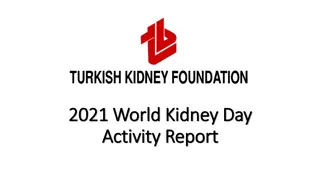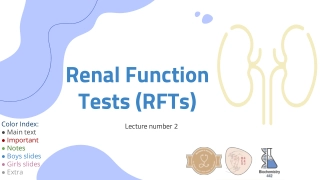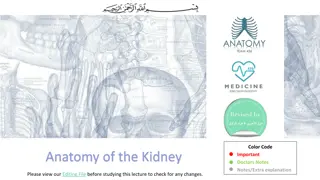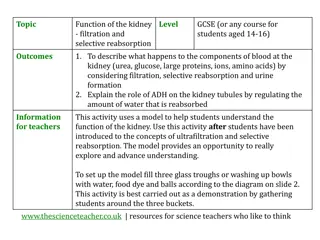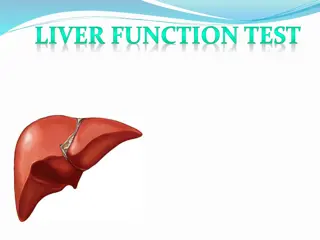Understanding Kidney Function and Laboratory Tests
This article delves into the structure and function of the kidneys, specifically focusing on nephrons and the implications of nephron loss. It also discusses the importance of blood urea and serum creatinine tests in evaluating kidney function, highlighting the differences between the two and their significance in assessing renal health. The content provides insights into the formation of nephrons, kidney maturation, and the relationship between nephron loss and renal insufficiency.
Download Presentation

Please find below an Image/Link to download the presentation.
The content on the website is provided AS IS for your information and personal use only. It may not be sold, licensed, or shared on other websites without obtaining consent from the author. Download presentation by click this link. If you encounter any issues during the download, it is possible that the publisher has removed the file from their server.
E N D
Presentation Transcript
Laboratory Training BLOOD UREA BLOOD CREATININE CREATININE CLEARANCE URIC ACID Mohammed Al-Zubaidi, PhD
Introduction The kidneys are two bean shaped organs lying retroperitoneally on each side of the vertebral column slightly above the level of umbilicus. The range in length & weight, respectively, from approximately 6cm & 24gms in a full term infant to more than/equal to 12cm & 150gms in an adult
Introduction Nephron Each kidney contains approx. 1 million nephrons. In humans, formation of nephron is complete at 36-40 weeks of gestation, but functional maturation with tubular growth & elongation continues during the 1st decade of life
Introduction Nephron Because new nephrons can t be formed after birth, so any disease that results in progressive loss of nephrons can lead to renal insufficiency. A decreased number of nephrons secondary to low birth weight, prematurity and/or unknown genetic or environmental factor is hypothesised to be a risk factor for the development of primary hypertension & Progressive Renal Dysfunction in adulthood.
Introduction A Nephron consist :- OUTER LAYER (the cortex) -glomeruli -PCT & DCT -CD INNER LAYER (the medulla) -Straight portion of tubules -LOH -vasa recta -terminal CD
Blood urea & serum creatinine Estimation of blood urea & serum creatinine are useful. These tests are less sensitive than the clearance tests. Serum creatinine is a better indicator than urea. But a markedly increased blood urea is conclusive evidence of severe impaired glomerular function. In chronic renal disease, the blood urea level correlates better with symptoms of uremia than does the serum creatinine. As a kidney function test, serum urea is inferior to serum creatinine because: High protein diet increases urea formation. Any condition of proteins catabolism (Cushing syndrome, diabetes mellitus, starvation, thyrotoxicosis) urea formation. 50 % or more of urea filtered at the glomerulus is passively reabsorbed by the renal tubules. The amount reabsorbed depends on flow rate. Therefore urea is less accurate than creatinine as an estimate of GFR.
Blood urea Urea forms in the liver and, along with CO2, constitutes the final product of protein metabolism. The amount of excreted urea varies directly with dietary protein intake, increased excretion in fever, diabetes, and increased adrenal gland activity. In the US and a few other countries, plasma or serum urea concentration is expressed as the amount of urea nitrogen, blood urea nitrogen (BUN). The test for BUN, which measures the nitrogen portion of urea, is used as an index of glomerular function in the production and excretion of urea. Chemical formula of urea is ( NH2)2>C=O i.e. Molecular weight of urea is 60 while nitrogen in it is 28 . 60/28 = 2.14 , so the conversion is blood urea nitrogen 2.14 = blood urea , a calculative value . Blood urea nitrogen normal value is between 6 and 20 mg per 100 ml while normal value of blood urea is between 15 and 40 mg per 100 ml.
Blood urea A normal level of blood urea is often mistakenly regarded to indicate normal kidney function. In a steady state the blood urea may not rise beyond the upper range of normal(40mg/dl) even when 75% of the renal function is lost. On the other hand, prerenal factors that decreases renal perfusion & GFR, such as dehydration, causes an increase in blood urea levels. There may be transient rise in blood urea level due to : - high protein intake & excessive protein catabolism ( e.g with severe infections, tissue breakdown, trauma, use of large doses of corticosteroids or tetracyclines) - gastrointestinal bleeding & inhibition of anabolism.
Blood urea Clinical implication Increased BUN levels (azotemia) occur in the following conditions: a. Impaired renal function caused by the following conditions: (1) Congestive heart failure (2) Salt and water depletion (3) Shock (4) Stress (5) Acute MI b. Chronic renal disease such as glomerulonephritis and pyelonephritis c. Urinary tract obstruction d. Hemorrhage into GI tract e. Diabetes mellitus with ketoacidosis f. Excessive protein intake or protein catabolism as occurs in burns or cancer g. Anabolic steroid use
Blood urea Decreased BUN levels are associated with the following conditions, although Clinically of little significance. a. Liver failure (severe liver disease), such as that resulting from hepatitis, drugs, or poisoning b. Acromegaly c. Malnutrition, low-protein diets d. Impaired absorption (celiac disease) e. Nephrotic syndrome (occasional) f. Syndrome of inappropriate antidiuretic hormone (SIADH)
Blood urea Interfering Factors 1. A combination of a low-protein and high-carbohydrate diet can cause a decreased BUN level. 2. The BUN is normally lower in children and women because they have less muscle mass than adult men. 3. Decreased BUN values normally occur in late pregnancy because of increased plasma volume (physiologic hydremia). 4. Older persons may have an increased BUN when their kidneys are not able to concentrate urine adequately. 5. IV feedings only may result in overhydration and decreased BUN levels. 6. Many drugs may cause increased or decreased BUN levels. Azotemia: Increase in the blood levels of NPN (creatinine, urea, uric acid) is referred to as azotemia & is the hallmark of kidney failure.
Blood urea Interventions Pretest Patient Care 1. Explain test purpose and blood-drawing procedure. Assess dietary history. Posttest Patient Care 1. Interpret test outcome and monitor as appropriate for impaired kidney function. 2. In patients with an elevated BUN level, fluid and electrolyte regulation may be impaired.
Blood urea CONTROL OF BLOOD UREA Correct intake of protein: If kidneys can t do their work properly, extra protein will increase the workload on kidneys. On the contrary, lack of protein may lead to malnutrition. Under this circumstance, it is necessary to restrict the amount of protein intake to 0.6-0.8g/kg every day. Supplement enough calories: This can reduce the consumption of protein in the body. Generally, it is suitable to take in 30Kca/Kg of calories every day.
Serum Creatinine & Creatinine Clearance Creatinine is derived from the metabolism of creatine and phosphocreatine, the bulk of which is in muscle. Creatine and creatine phosphate exist in a reversible equilibrium in skeletal muscle. In skeletal muscle, approximately one-fourth of creatine exists as free creatine and three-fourth exists as creatine phosphate. Since creatinine is chiefly excreted by glomerular filteration, S.creatinine levels reflects changes in GFR. S.creatinine values are low when the muscle mass is decreased, as in malnutrition. Bilirubin interferes with creatinine measurements.
Serum Creatinine Serum creatinine affected partly by: 1. The amount of muscle tissue you have. Men tend to have higher levels of blood creatinine because they have more skeletal muscle tissues than women. 2. Protein in diet. Vegetarians have been shown to have lower creatinine levels in blood. This test diagnoses impaired renal function. It is a more specific and sensitive indicator of kidney disease than BUN, although in chronic renal disease, both BUN and creatinine are ordered to evaluate renal problems because the BUN-to-creatinine ratio provides more information.
Serum Creatinine Reference Values Normal Adult men: 0.9 1.3 mg/dL Adult women: 0.6 1.1 mg/dL BUN-to-creatinine ratio: 10:1 to 20:1 Clinical alert: Critical value is 10 mg/dL in nondialysis patients. Procedure 1. Obtain a 5-mL venous blood sample. Serum is preferred, but heparinized blood can be used. Place specimen in a biohazard bag. 2. Observe standard precautions.
Serum Creatinine Clinical Implications 1. Increased blood creatinine levels occur in the following conditions: a. Impaired renal function b. Chronic nephritis c. Obstruction of urinary tract d. Muscle disease (1) Gigantism (2) Acromegaly (3) Myasthenia gravis (4) Muscular dystrophy (5) Poliomyelitis e. Congestive heart failure f. Shock g. Dehydration h. Rhabdomyolysis (skeletal muscle tissue breakdown) i. Hyperthyroidism
Serum Creatinine 2. Decreased creatinine levels occur in the following conditions: a. Small stature b. Decreased muscle mass c. Advanced and severe liver disease d. Inadequate dietary protein e. Pregnancy (0.4 0.6 mg/dL is normal; 0.8 mg/dL is abnormal and should be noted) 3. Increased ratio (>20:1) with normal creatinine occurs in the following conditions: a. Increased BUN (prerenal azotemia), heart failure, salt depletion, dehydration b. Catabolic states with tissue breakdown c. GI hemorrhage d. Impaired renal function plus excess protein intake, production, or tissue breakdown
Serum Creatinine 4. Increased ratio (>20:1) with elevated creatinine occurs in the following conditions: a. Obstruction of urinary tract b. Prerenal azotemia with renal disease 5. Decreased ratio (<10:1) with decreased BUN occurs in the following conditions: a. Acute tubular necrosis b. Decreased urea synthesis as in severe liver disease or starvation c. Repeated dialysis d. SIADH e. Pregnancy 6. Decreased ratio (<10:1) with increased creatinine occurs in the following conditions: a. Phenacemide therapy (accelerates conversion of creatine to creatinine) b. Rhabdomyolysis (releases muscle creatinine) c. Muscular patients who develop renal failure
Serum Creatinine Interfering Factors 1. High levels of ascorbic acid and cephalosporin antibiotics can cause a falsely increased creatinine level; these agents also interfere with the BUN-to-creatinine ratio. 2. Drugs that influence kidney function plus other medications can cause a change in the blood creatinine level. 3. A diet high in meat can cause increased creatinine levels. 4. Creatinine is falsely decreased by bilirubin, glucose, histidine, and quinidine compounds. 5. Ketoacidosis may increase serum creatinine substantially.
Serum Creatinine Interventions Pretest Patient Care 1. Explain test purpose and procedure. 2. Assess diet for meat and protein intake. Posttest Patient Care 1. Interpret test results and monitor as appropriate for impaired renal function. 2. Possible treatment includes hemodialysis and renal replacement therapy, including kidney transplant.
Clearance test Test for glomerular filtration rate (GFR) Useful index for the assessment of severity of kidney damage The concept of clearance is based upon the fact that the rate of removal of a substance from the plasma must equal its simultaneous rate of excretion in urine. Thus, Clearance is defined as the quantity of blood or plasma that is completely cleared of a substance per unit time Alternatively >>>> ml of plasma which contains the amount of that substance excreted by kidney within a minute Units: ml/min
Clearance test Types of Clearance tests Endogenous Exogenous Creatinine Inulin Cystatin C Para-amino hippuric acid (PAHA) Diodrast (di-iodo pyridone acetic acid) Calculation: (U X V)/P Where: U = concentration of substance in urine (mg/dl) V = volume of urine excreted per minute (ml/min) P = concentration of substance in plasma/serum (mg/dl)
Clearance test The best substance to use for glomerular clearance: It is filtered completely through the glomerulus and not reabsorbed through the nephron tubule It is not affected by endogenous and exogenous factors Renal Clearance of INULIN is the Gold Standard for determination of GFR. However, inulin does not occur naturally in the body and requires several hours of infusion to reach steady state concentration. 51Cr-EDTA clearance closely resembles Inulin clearance & it is the radionuclide of choice for GFR estimation in Europe. However, 99m Tc-DTPA is often the preferred agent, because 99m Tc-DTPA is inexpensive, easily available & renal imaging can be simultaneously performed. GFR can be estimated based upon either plasma clearance or upon the tracer uptake by the kidneys.
Clearance test CYSTATIN C : It is a LMW nonglycosylated protein produced at a constant rate by all nucleated cells in the body, freely filtered by the glomeruli, not secreted, but totally reabsorbed by the renal tubules. Little or no cystatin is excreted in urine. Normal adults have circulating level of approx. 1mg/l. This is better indicator of renal function as compared to creatinine in early stages of GFR impairment as it is independent of age, gender, body composition & muscle mass. Cystatin C can be estimated in blood by enzyme immunoassays or immunoturbidometry. Both techniques are currently kit based & expensive.
Creatinine clearance test Creatinine clearance test measures the rate at which the kidneys are able to remove (to clear) a filterable substance from the blood. creatinine clearance is a rough measure of the glomerular filtration rate a) Serum creatinine conc (Crs) b) Urine creatinine conc ( Cru) c) Urine Volume Creatinine clearance=(Cru x V/t) / Crs Normal range male = 85 125 ml/min female = 75 115 ml/min
Creatinine clearance test In clinical practice creatinine clearance may be used to estimate GFR for the following reasons: 1. Inulin is not produced endogenously. Therefore, it must be infused intravenously if it is to be used in renal function tests. So, it is much more convenient to use a substance that is normally present in plasma that is freely filtered, but neither secreted, nor reabsorbed. 2. Creatinine, a normal breakdown product of creatine, is an endogenous compound that fulfills these criteria. Endogenous creatinine production is constant as long as the muscle mass remains constant. Because all creatinine filtered by the kidneys in a given time interval is excreted into the urine, creatinine levels are equivalent to the glomerular filtration rate (GFR). Disorders of kidney function prevent maximum excretion of creatinine. The creatinine clearance test is a specific measurement of kidney function, primarily glomerular filtration. It measures the rate at which the kidneys clear creatinine from the blood. However, in humans, a small amount of creatinine is secreted into the urine in the proximal tubules. Consequently, the rate of excretion of creatinine exceeds its rate of filtration by 5 to 10%. The clearance of creatinine thus exceeds the true GFR by 5 to 10%.
Creatinine clearance test In renal failure the kidney will not be able to excrete creatinine in urine leading to an elevation in serum creatinine level. Both serum Cr. and creatinine clearance are used as kidney function tests to : Confirm the diagnosis of renal disease. Give an idea about the severity of the disease. Follow up the treatment. A raised serum creatinine is a good indicator of impaired renal function But normal serum creatinine does not necessarily indicate normal renal function as serum creatinine may not be elevated until GFR has fallen by as much as 50%
Creatinine clearance test In the traditional method, creatinine content of a 24 hr urine collection & the plasma concentration in this period are estimated. Try this: calculate the creatinine clearance Using urine creatinine of 120mg/dl, serum creatinine of 1.0 mg/dl and urine volume of 1440 ml obtained from 24 hour specimen. Calculate the GFR Answer ? Creatinine clearance = (Cru x V/t) / Crs = [120mg/dl x 1440ml / (24h x 60min)]/1.0mg/dl =[120 x 1440ml / 1440min]/1.0 =120ml/min
Creatinine clearance test Clinical Implications 1. Decreased creatinine clearance is found in any condition that decreases renal blood flow: a. Impaired kidney function, intrinsic renal disease, glomerulonephritis, pyelonephritis, nephrotic syndrome, acute tubular dysfunction, amyloidosis, interstitial nephritis b. Shock, dehydration c. Hemorrhage d. Chronic obstructive lung disease e. Congestive heart failure 2. Increased creatinine clearance is found in: a. State of high cardiac output b. Pregnancy c. Burns d. Carbon monoxide poisoning
Creatinine clearance test 3. Increased urine creatinine is found in: a. Acromegaly b. Gigantism c. Diabetes mellitus d. Hypothyroidism 4. Decreased urine creatinine is found in: a. Hyperthyroidism b. Anemia c. Muscular dystrophy d. Polymyositis, neurogenic atrophy e. Inflammatory muscle disease f. Advanced renal disease, renal stenosis g. Leukemia
Creatinine clearance test Interfering Factors 1. Exercise may increase creatinine clearance and urine creatinine. 2. Pregnancy substantially increases creatinine clearance. 3. Many drugs decrease creatinine clearance. 4. The creatinine clearance overestimates the GFR when there is severe renal impairment. The serum creatinine is more indicative of the GFR in this situation. 5. A diet high in meat may elevate the urine creatinine concentration. 6. Proteinuria and advanced renal failure make creatinine clearance an unreliable method for determining GFR.
Creatinine clearance test Interventions Pretest Patient Care 1. Instruct the patient about the purpose and procedure of the test and urine specimen collection. A written reminder may be helpful. 2. Allow food and encourage fluids for good hydration. Large urine volumes ensure optimal test results. Avoid tea and coffee (diuretics). 3. Avoid vigorous exercise during the test. 4. Drugs affecting the results should be stopped beforehand (especially adrenocorticotropic hormone [ACTH], cortisone, or thyroxine). 5. Avoid eating large amounts of meat. Posttest Patient Care 1. The patient may resume normal food, fluids, and activity. 2. Interpret test outcomes and monitor appropriately.
Creatinine clearance test Limitations of creatinine clearance Includes both GFR and secretion May overestimate GFR when GFR is low (due to secretion) Excellent for estimation of GFR in healthy individuals
Uric acid Uric acid is formed from the breakdown of nucleic acids and is an end product of purine (adenosine and guanine) metabolism in the liver. Uric acid is transported by the plasma from the liver to the kidney, where it is filtered and where about 70% is excreted in urine. The remainder of uric acid is excreted into the GI tract.
Uric acid Renal handling of uric acid is complex and involves four sequential steps 1.Glomerular filtration of virtually all the uric acid in capillary plasma entering the glomerulus. 2.Reabsorption in the proximal convoluted tubule of about 98% to 100% of filtered uric acid. 3.Subsequent secretion of uric acid into the lumen in the distal portion of the proximal tubule. 4.Further reabsorption in the distal tubule. The net urinary excretion of uric acid is 6% to 12% of the amount filtered. Uric acid in urine exists as mono- and di-sodium, potassium, ammonium and calcium urates.
Uric acid Clinical applications Uric acid is measured to : Diagnosis and monitor treatment of gout. Diagnosis of renal calculi Detect kidney function. Assess inherited disorders of purine metabolism Monitor if uric acid levels are too high after chemotherapy or radiation.
Uric acid Reference Values Normal Men: 3.4 7.0 mg/dL Women: 2.4 6.0 mg/dL Clinical Significance 1. Disease states with increased plasma uric acid (Hyperuricemia) Gout Increased catabolism of nucleic acids renal disease Metabolic acidosis, diabetic ketoacidosis Leukemia, multiple myeloma, lymphoma
Uric acid 2. Decreased levels of uric acid (Hypouricemia) occur in the following conditions: Fanconi s syndrome (disease of the proximal renal tubules) Wilson s disease (autosomal recessive disorder resulting in the accumulation of copper in tissues) SIADH Some malignancies (e.g., Hodgkin s disease, multiple myeloma) Xanthinuria (deficiency of xanthine oxidase) Interfering Factors 1. Stress and strenuous exercise will falsely elevate uric acid. 2. Many drugs cause increase or decrease of uric acid. 3. Purine-rich diet (e.g., liver, kidney, sweetbreads) increases uric acid levels. 4. High levels of aspirin decrease uric acid levels. 5. Low purine intake, coffee, and tea decrease uric acid levels.
Uric acid Interventions Pretest Patient Care 1. Advise patient of test purpose and blood-drawing procedure; fasting is preferred. 2. Promote relaxation; avoid strenuous exercise. Posttest Patient Care 1. Have patient resume normal activities. 2. Interpret test results and monitor appropriately for renal failure, gout, or leukemia. Uric acid level should fall in patients who are treated with uricosuric drugs such as allopurinol, probenecid, and sulfinpyrazone.
Uric acid Gout Gout is due to elevated levels of uric acid in the blood. This occurs due to a combination of diet and genetic factors. In Gout increased serum levels of uric acid lead to formation of monosodium urate crystals around the joints. Uric acid test is useful to assess for gout and to monitor patients with renal failure Primary gout: is a condition in which uric acid is synthesized in excess and decreased ability of plasma to retain uric acid in solution. The cause for primary gout is unknown , but there is a metabolic disorder. Secondary gout: is accumulation of uric acid in plasma, than other tissues, due to increased purines catabolism, it is not due to excessive synthesis of uric acid
Uric acid Uric acid stone formation Saturation levels of uric acid in blood may result in one form of kidney stones when the urate crystallizes in the kidney. These uric acid stones are radiolucent and so do not appear on an abdominal plain X-ray, and thus their presence must be diagnosed by ultrasound for this reason or stone protocol CT. Very large stones may be detected on X-ray by their displacement of the surrounding kidney tissues
Uric acid CONTROL OF URIC ACID Adjust Diet: To gain control of uric acid levels, avoid eating foods high in purine. Limit Alcohol: Because alcohol dehydrates the body, it is advisable to limit consumption, particularly when consumed with foods high in purine. Water: Keep your body hydrated.








